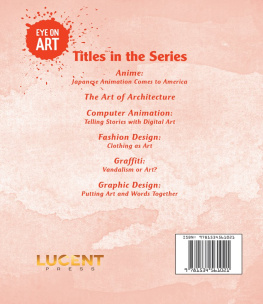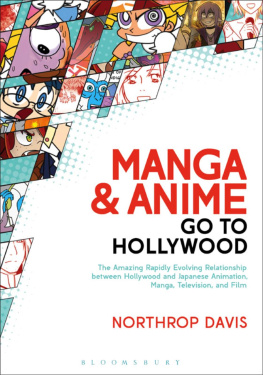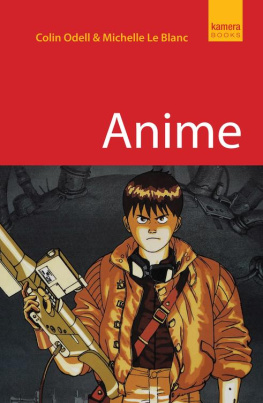Acknowledgments
No thank you would be complete without remembering the anime tape dealers I encountered at comics shows and conventions in the 1990s, who were an integral part of my anime education. This shout-out goes to Mike Temple, Victor Gong, their various associates, and a fellow known only as Dave for being there when anime had only a small cult following in the U.S. and was so hard to find.
Thanks to James Pallot, Jacob Levitch, and Edmond Grant, editors of The Motion Picture Guide , the first publication to which I regularly contributed reviews of anime. Id like to acknowledge my editors at Kidflix.com (later renamed FamilyWonder.com), Todd Yellin and Betsy Wallace for giving me the great joy of immersing myself in Pokmon , Sailor Moon , Digimon , Gundam Wing , and other series for the site, and the opportunity to conduct my first anime interviews, including one with Hayao Miyazaki.
Thanks to Julie Davis, editor of Animerica Magazine , the publication that provided my longest stretch of freelance anime journalism (and, not coincidentally, my editor and collaborator on this book), and her successor, Kelli Blackwell, for six years of regular reviewing and writing about anime, an unmistakable highlight of my freelance career and the best opportunity Ive had to hone my skills as an anime critic.
The final stage of this journey began in March 2005 when I was asked by Hikari Hori and Ryo Nagasawa to introduce some films being shown at Japan Society in New York as part of their Otaku Cinema Slam! series, staged in conjunction with the Societys gallery exhibit, Little Boy: The Arts of Japans Exploding Subculture. I discussed my interests with both women and they encouraged me to write a book about anime. Hikari gave me a contact at Stone Bridge Press, I submitted a proposal, and the end result is the book you are holding in your hands.
I must also thank my colleagues at CUNY-TV, the cable television station of The City University of New York, for their patience during the year and a half I was preoccupied with this book and their understanding when I needed days off to meet various deadlines. It would have been much more difficult to accomplish this task without their continued support .
And last, but not least, I dedicate this book to my daughter, Alexis Camp, who has shared so much of this journey with me, from the time I took her to see Miyazakis Laputa: Castle in the Sky when she was seven years old and the years I attended comics shows and anime conventions with her in tow, to the press screenings of the first four Pok mon movies we attended and the joint interview we conducted with voice actress Veronica Taylor (Ash Ketchum, Pokmon ). Its been an exciting ride.
brian camp
A very special thanks goes out to the many wonderful industry representatives who provided us with images for this book: John ODonnell and Mike Lackey at Central Park Media; Jeff Dronen at FUNimation, Inc.; Lisa Cooper at The Right Stuf International; Jane Lui and Liza Coppola at Viz Media; Shizuka Yamashita and Krystal Sae Eua at Broccoli International USA, Inc.; Chris Oarr at ADV Films; Kaoru Miyazaki at Bandai Visual; and Donna Lopez at Media Blasters. A very special thanks also to Nina Wegner at Stone Bridge Press, for so patiently working through the edits on this text, and to Linda Ronan, for the design and layout.
Thanks to Le Video, Japan Video, and People Video & CD Rentals of San Francisco for still stocking VHS rarities. Thanks also to Netflix for existing.
To my former coworkers at Viz Media, especially Animerica staffers Kelli Blackwell, Urian Brown, Winnie Chow, Kit Fox, Patrick Macias, Andy Nakatani , Janet Piercy, Andrea Rice, David Torres, Rio Yaez, and most especially Founding Editor Trish Ledoux, thanks are not enough for all the years of hard work and inspiration and utter enjoyment that I was lucky enough to share with you all. To Toshifumi Yoshida, Takayuki Karahashi, James Teal, and the rest of the staff of Animag , thank you for introducing me to the wider world of anime and all the joys it holds.
Finally, to my husband, Mark Simmons, who provided invaluable research and translation help throughout this project, and shared his own wealth of anime knowledge and insights. My own dedication goes out to you, the best friend I could ever have, and my partner in pop culture scholarship. Thank you for listening, for debating ideas, but most of all, just for being you.
julie davis
About the Authors
brian camp has been writing about film for over thirty years, with special interests in Asian cinema and animation. A graduate of Hunter College and New York University, he has covered anime regularly since 1994, and contributed articles and reviews to Animerica, Anime & Manga Monthly. He has lectured on anime in various educational settings and has taught a course on anime at New Yorks School of Visual Arts. He currently serves as a TV programmer for CUNY-TV, the cable TV channel of The City University of New York.
julie davis began writing about anime in 1991 for Animag, The Magazine of Japanese Animation . She went on to become a frequent contributor, and then editor-in-chief, of Animerica, Anime & Manga Monthly , and a senior manga editor at Viz Comics. She has contributed articles to Manga Mania and Otaku USA , and has regularly attended and spoken at comic book and animation conventions for over a decade. A graduate of the University of Michigan, specializing in photography and Asian art, Davis continues to study world pop culture and fine art, and currently works as a San Franciscobased writer and editor.


PUBLISHED BY
Stone Bridge Press
P.O. Box 8208
Berkeley, CA 94707
www.stonebridge.com sbp@stonebridge.com
Front cover image used by permission of Gainax . GAINAX/ABENOBASHI Committee.
Dragon Ball Z and all logos, character names, and distinctive likenesses thereof are trademarks of T oei Animation. Macross is a registered trademark of Harmony Gold USA, Inc. Pokmon properties are trademarks of Nintendo.
Cover, text design, and additional line drawings by Linda Ronan.
Text 2007 Brian Camp and Julie Davis.
All rights reserved. No part of this book may be reproduced in any form without permission from the publisher.
LIBRARY OF CONGRESS CATALOGING-IN-PUBLICATION DATA
Camp, Brian.
Anime classics zettai! : 100 must-see Japanese animation masterpieces / Brian Camp and Julie Davis.
p. cm.
Includes bibliographical references.
ISBN 978-1-933330-22-8 (pbk.)
1. Animated filmsJapanReviews. 2. Animated television programsJapanReviews.
I. Davis, Julie. II. Title.
NC1766.J3C36 2007
791.43'75--dc22
2007025423
INTRODUCTION

Anime ClassicsIts About Time
By Brian Camp
In the early 1990s, anime fans in America were a small but hearty bunch. Some were veteran TV watchers who recalled how Japanese imports like Astro Boy , Gigantor , and Tobor, the 8 th Man so enthralled them as kids because they looked so different from every other cartoon. Some were younger fans whod watched Star Blazers and Robotech religiously and wondered why American television couldnt come up with serious animated science fiction shows with continuing story lines like that. There were those who discovered Hayao Miyazakis epic spectacles through big-screen festival showings of Laputa: Castle in the Sky or Castle of Cagliostro , and animes futuristic cyberpunk bent through Katsuhiro Otomos Akira . Of all of these, Akira was perhaps the most influential, a film that almost single-handedly directed the worlds attention to anime as an innovative art form capable of entrancing adult audiences with complex stories and breathtaking visual detail. Most Western audiences, though, still didnt know what anime was, or knew it only as Japanese cartoons.














